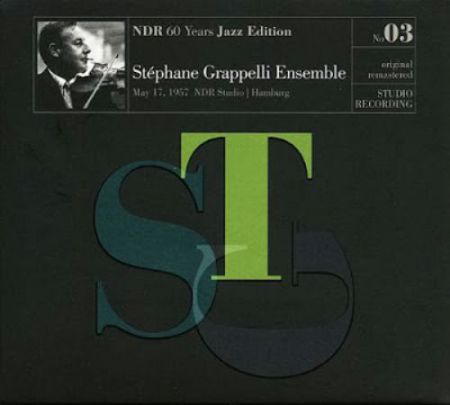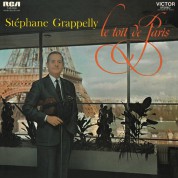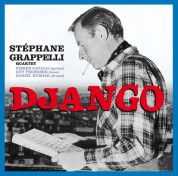
NDR 60 Years Jazz Edition (SG) - Plak
Tükendi
Bu Ürün Stoklarımıza Girince Haberdar Olmak İster Misiniz?
(+) Stoklara Girince Haber Ver
(+) Stoklara Girince Haber Ver
Ürün Hakkında
Barkod: 4017425130317
, Katalog No: MS1003 , Firma: Moosicus Records
, Yayınlanma Tarihi:
2014
Tür:
Caz - Blues
Format Türü: Plak, Format: 2 LP
ENGLISH
<p><b>NDR 60 YEARS JAZZ EDITION No. 03</b></p> <p><b>Stéphane Grappelli Ensemble ' </b><b>17 May 1957, Hamburg, NDR Studio</b></p> <p>Swinging Violin</p> <p>On the 17th of May 1957 Stéphane Grappelli came to Hamburg for a recording session with a quartet in Studio 1 of the Norddeutscher Rundfunk radio broadcaster. From today's perspective the trip was a rare event for the then 49-year-old jazz musician, because from the end of the 1940s until the mid-1960s he was rarely to be found in a recording studio anywhere, even though he was already one of the world's best jazz violinists. His studio absence is particularly puzzling given that up to his death on the 1st of December 1997 he was probably one of the most recorded violinists in the history of music of the 20th century. But from this roughly 15-year period there is actually just a handful of released recordings by and with Stéphane Grappelli.</p> <p>For the jazz violinist the years before making his trip to Hamburg in 1957 were a time of upheaval and change which left a "gap" in Grappelli's CV and discography. There are several reasons for this. One of them lies in the technical developments of the time. Music became louder. Electric guitars, improved microphones and the voluminous sound, in particular of the brass section, also led to a broadening of the dynamic spectrum in jazz. With its delicate acoustics it was difficult for a violin to assert itself against the other instruments without amplification. Before coming to Hamburg, Grappelli had already started experimenting with various pick-up systems. But he was generally dissatisfied with the results because the electrification of his instrument had an excessively alienating effect on the unique timbre of the violin and the ambience was lost. This is why he often preferred a chamber music setting in the recording studio, as this gave him the best acoustic results with just a simple microphone. </p> <p>Another reason was of a personal nature. On the 16th of May 1953 the Manouche guitarist "Django" Reinhardt died. The death of his long-time friend and musical companion had deeply wounded Stéphane Grappelli. He rarely spoke about this loss. When he did, then he spoke about the years between 1934 and 1939, when they both fronted the now legendary Quintette du Hot Club de France. It was the countless recordings with this band that earned Grappelli and Reinhardt their reputation as "legends" of early European jazz. Here and in the USA: with the then so popular Hot Jazz which the pair mixed from the very beginning of their percussionless band with the Musette waltzes typical of French dance music and the music of the Manouches, the French Gypsies. </p> <p>When the Second World War broke out on the 1st of September 1939, the Quintette du Hot Club de France was on tour in England. While one, Reinhardt, returned to his homeland of France, the other, Grappelli, remained in London. In his English exile the violinist became acquainted with George Shearing. An encounter with consequences. Because Grappelli ' who had taught himself to play the violin as a youth before going to study classical violin at the venerable Conservatoire de Paris, after which, like many musicians of the time, he earned his livelihood playing with dance orchestras in the French capital ' was always interested in being part of new musical developments. With the blind pianist who was more than ten years younger and his concept of block chords, Grappelli was given the opportunity to learn what was for him an unknown harmonic language in jazz.</p> <p>But above all, up to the late 1950s Grappelli was still working on perfecting his instrumental skills. While his solo choruses on the violin with the Quintette du Hot Club de France mainly involved intensifying ornamentations, tension-escalating vibrati, glissandi and tremoli, short fill-ups and improvised melodic phrases, in the years after the end of the war he expanded the range of forms of expression on his instrument. He was inspired, for example, by the "Bel Canto" playing of the classical violin virtuosos, taught himself different type of bow strokes, and learned an unusual grip technique for the violin in order to be able to fly over the strings with the minimum of pressure. But above all he emotionalised his sound using a technique with which he preceded the played notes with a glissando from below. </p> <p>Stéphane Grappelli's visit to Studio 1 at the Norddeutscher Rundfunk in Hamburg in 1957 was then indeed a stroke of luck. Because on this day he had for the first time the complete repertoire of forms of expression on the violin which made him the style-forming jazz musician who earned the admiration even of instrumentalists in other genres such as the great classical violinist Yehudi Menuhin. At the same time, his tone and phrasing still had the vitality and virility of his younger years with the Quintette du Hot de France in the 1930s. And even more: In 1957 he was able to build a bridge with his violin between the swinging grandezza of the US jazz musicians and the great tradition of European music. </p> <p>A major factor in making the recording session in Studio 1 of the NDR a field of experimentation for Grappelli was his rhythm group. This included his twenty-years-younger compatriot, the pianist Maurice Vander, and the two Germans Hans Last on the contra bass (yes, you've read it correctly: years later "Hans" was to become "James" Last) and Rolf Ahrens on percussion. With delicate harmony and colourful melody the three musicians cleared the ground for their leader to experiment with his violin: with his soft and broad legato bowing technique, for example, which allowed him to achieve such naturally swinging phrasing, particularly in the ballads and mid-tempo numbers, as the great US saxophonists at the time, with his sharp pizzicato which gave his solo choruses a dynamically differentiated energy level, or with his sensational flageolet tones in preparation for the climaxes of his improvisations. </p> <p>Even though at first glance the repertoire recorded in Hamburg with its mixture of songs from the "Great American Songbook" ("St. Louis Blues" for example, or "Lady Be Good" and "The Lady Is A Tramp") and pieces, for example, by Django Reinhardt (in particular "Manoir De Mes Rêves" and "Nuages") appeared to offer little spectacular, in its natural and self-evident way this studio session was an illustration of what was to be Grappelli's life-long guiding principle: "Jazz is all about feeling: It is a matter of the heart", as he once summarised it in simple words "It is only when you have the feeling that the music happens as if by itself."</p>Eser Listesi
- 1. Autumn in New York
- 04:31

- 2. Jeepers Creepers
- 02:29

- 3. These foolish things
- 04:27

- 4. She's funny that way
- 03:35

- 5. Nuages / Swing
- 03:47

- 1. It might as well be spring
- 05:13

- 2. Hambourg souvenir
- 03:50

- 3. Vours qui passez sand me voir
- 02:56

- 4. Lady be good
- 02:08

- 5. A flower is a love-some thing
- 04:09

- 1. I can't believe that you're in love with me
- 03:03

- 2. Manoir de mes reves
- 03:25

- 3. How about you?
- 03:10

- 4. The lady is a tramp
- 03:30

- 5. St. Louis Blues
- 05:11

- 1. A girl in Calico
- 02:59

- 2. I'll remember April
- 02:59

- 3. Blue moon
- 03:02

- 4. How high the moon
- 03:57

- 5. Pennies from Heaven
- 02:48

Katkıda Bulunanlar
|
|
Bu Ürünler İlginizi Çekebilir







